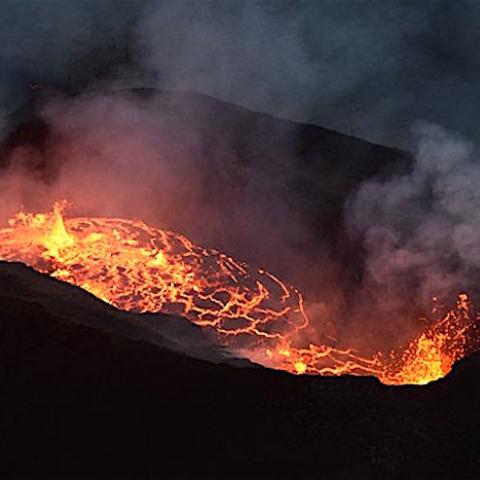
Pu‘u ‘Ō‘ō has turned quiet at Hawai'i Volcanoes National Park/11-6-2018, USGS
Arguably the biggest story in the National Park System last year centered on the eruptions surrounding Pu‘u ‘Ō‘ō on the Kīlauea Volcano's East Rift Zone at Hawai'i Volcanoes National Park. Now, however, U.S. Geological Survey scientists say it appears Pu‘u ‘Ō‘ō is spent.
In their Volcano Watch column last week, USGS researchers at the Hawaiian Volcano Observatory noted that January 3, 2018, marked the 35th anniversary of Pu‘u ‘Ō‘ō. For the past 35 years, they added, "lava has erupted almost continuously from the middle East Rift Zone. Minor pauses in surface activity mostly occurred between the fountaining episodes in 1983 – 1986, and subsequently during a few episodes marked by subsidiary fissures, intrusions, or partial crater floor collapses."
That sort of reliability in terms of lava flow had spoiled the researchers, and "(T)he lure of reliable lava viewing beckoned to millions of tourists around the globe."
Looking back over those decades of eruptions, there have been more than 100 "brief pauses in surface activity," USGS notes, with most lasting a handful of hours to a couple of days. "The six longest pauses during the Pu‘u ‘Ō‘ō activity were each 1 to 2-months-long, and all occurred between fountaining episodes in the first two years," the column goes on. "Specifically, long pauses between fountains occurred spanning episodes 3 and 4 (65 days), episodes 32 and 33 (52 days), episodes 12 and 13 (50 days), episodes 39 and 40 (49 days), episodes 25 and 26 (43 days), and episodes 31 and 32 (38 days)."
Everything about Pu‘u ‘Ō‘ō's behavior changed on April 30, 2018.
"The catastrophic collapse of Pu‘u ‘Ō‘ō has left the iconic eruption site and surrounding lava flow fields devoid of lava through the rest of 2018. December 30th marked the seven-month anniversary of no surface activity at Pu‘u ‘Ō‘ō and is effectively a concluding milestone for this long-lived event," the column notes.
The Smithsonian Institution's Global Volcanism Program (GVP) (https://volcano.si.edu/) classifies the end of continuous volcanic activity based on an absence of eruptive activity over a 90-day period, according to USGS.
"Statistically, after a 210-day gap in activity, it is extremely unlikely that lava will resume activity within Pu‘u ‘Ō‘ō. Based on historical knowledge of rift zone eruptions, pauses lasting more than three-and-a-half months have ended their respective eruption," it added. "Given the GVP criterion, no signs of imminent unrest, and that December 30th, 2018 marks 7 months of no lava, then the Pu‘u ‘Ō‘ō eruption could be considered over. The 36th anniversary of continuous eruption, on January 3, 2019," did not come to pass.
But, USGS researcher say, "this does not mean Kīlauea Volcano is dead. New eruptions have previously begun elsewhere on Kīlauea after months to decades of quiet. Magma is being supplied to the volcano, and deformation data shows evidence for movement of molten rock through the magmatic system, refilling the middle ERZ. It's important to note that Kīlauea is still an active volcano that will erupt in the future, and associated hazards have not changed. When a new eruption does occur, ground cracking, gas emissions, seismicity, and deformation can increase rapidly."
The USGS Hawaiian Volcano Observatory continues to closely monitor Kīlauea Volcano through ground-based observations, helicopter overflights, and geophysical instrument networks.



 Support Essential Coverage of Essential Places
Support Essential Coverage of Essential Places







Add comment